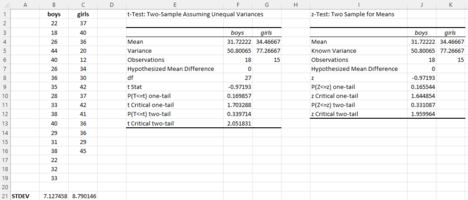Mackattack
New member
- Joined
- Oct 14, 2020
- Messages
- 29
Hello. I'm comparing the test scores of boys and girls to see if there's a significant difference. I'm confused about whether I should use T-test or Z-test. There are 33 students—18 are boys and 15 are girls. I know that Z-test is used when n>30 but does that only apply if either boys or girls are more than 30, or if boys and girls combined are more than 30? Either way, both tests say to accept null hypothesis, and the critical values are not that far from each other. Additionally, can I still use T-test if the number of both girls and boys is 35? Thank you.


